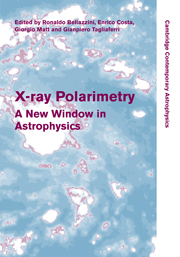Book contents
- Frontmatter
- Contents
- List of contributors
- Preface
- 1 X-ray polarimetry: historical remarks and other considerations
- Part I Polarimetry techniques
- Part II Polarized emission in X-ray sources
- 14 Probing strong gravity effects with X-ray polarimetry
- 15 X-ray polarization from black holes in the thermal state
- 16 Strong-gravity effects acting on polarization from orbiting spots
- 17 Polarization of thermal emission from accreting black holes
- 18 X-ray polarimetry and radio-quiet AGN
- 19 The soft X-ray polarization in obscured AGN
- 20 The polarization of complex X-ray sources
- 21 Polarization of Compton X-rays from jets in AGN
- 22 Polarization of X-ray lines from galaxy clusters and elliptical galaxies
- 23 Polarization characteristics of rotation-powered pulsars
- 24 Polarized X-rays from magnetized neutron stars
- 25 Polarization properties of X-ray millisecond pulsars
- 26 X-ray polarization signatures of neutron stars
- 27 Polarization from the oscillating magnetized accretion torus
- 28 X-ray polarization from accreting white dwarfs and associated systems
- 29 Polarization of pulsar wind nebulae
- 30 X-ray polarization of gamma-ray bursts
- 31 Central engine afterglow from GRBs and the polarization signature
- 32 GRB afterglow polarimetry past, present and future
- 33 Gamma-ray polarimetry with SPI
- 34 INTEGRAL/IBIS observations of the Crab nebula and GRB 041219A polarization
- 35 Fermi results on the origin of high-energy emission in pulsars
- 36 Diagnostics of the evolution of spiral galaxies in a cluster environment
- Part III Future missions
- Author index
- Subject index
24 - Polarized X-rays from magnetized neutron stars
from Part II - Polarized emission in X-ray sources
Published online by Cambridge University Press: 06 July 2010
- Frontmatter
- Contents
- List of contributors
- Preface
- 1 X-ray polarimetry: historical remarks and other considerations
- Part I Polarimetry techniques
- Part II Polarized emission in X-ray sources
- 14 Probing strong gravity effects with X-ray polarimetry
- 15 X-ray polarization from black holes in the thermal state
- 16 Strong-gravity effects acting on polarization from orbiting spots
- 17 Polarization of thermal emission from accreting black holes
- 18 X-ray polarimetry and radio-quiet AGN
- 19 The soft X-ray polarization in obscured AGN
- 20 The polarization of complex X-ray sources
- 21 Polarization of Compton X-rays from jets in AGN
- 22 Polarization of X-ray lines from galaxy clusters and elliptical galaxies
- 23 Polarization characteristics of rotation-powered pulsars
- 24 Polarized X-rays from magnetized neutron stars
- 25 Polarization properties of X-ray millisecond pulsars
- 26 X-ray polarization signatures of neutron stars
- 27 Polarization from the oscillating magnetized accretion torus
- 28 X-ray polarization from accreting white dwarfs and associated systems
- 29 Polarization of pulsar wind nebulae
- 30 X-ray polarization of gamma-ray bursts
- 31 Central engine afterglow from GRBs and the polarization signature
- 32 GRB afterglow polarimetry past, present and future
- 33 Gamma-ray polarimetry with SPI
- 34 INTEGRAL/IBIS observations of the Crab nebula and GRB 041219A polarization
- 35 Fermi results on the origin of high-energy emission in pulsars
- 36 Diagnostics of the evolution of spiral galaxies in a cluster environment
- Part III Future missions
- Author index
- Subject index
Summary
We review the polarization properties of X-ray emission from highly magnetized neutron stars, focusing on emission from the stellar surfaces. We discuss how X-ray polarization can be used to constrain neutron star magnetic field and emission geometry, and to probe strong-field quantum electrodynamics and possibly constrain the properties of axions.
Introduction
One of the most important advances in neutron star (NS) astrophysics in the last decade has been the detection and detailed studies of surface (or near-surface) X-ray emission from a variety of isolated NSs. This has been made possible by X-ray telescopes such as Chandra and XMM-Newton. Such studies can potentially provide invaluable information on the physical properties and evolution of NSs (e.g. equation of state at super-nuclear densities, cooling history, surface magnetic fields and compositions, different NS populations). The inventory of isolated NSs with detected surface emission includes: (i) radio pulsars: e.g. the phase-resolved spectroscopic observations of the ‘three musketeers’ revealed the geometry of the NS polar caps; (ii) magnetars (AXPs and SGRs): e.g. the quiescent emission of magnetars consists of a black body at T ∼ 0.5 keV with a power-law component (index 2.7–3.5), plus significant emission up to ∼ 100 keV; (iii) central compact objects (CCOs) in SNRs: these now include six to eight sources, several have P, measurements and two have absorption lines; (iv) thermally-emitting isolated NSs: these are a group of seven nearby (≲1 kpc) NSs with low (∼1032 erg s−1) X-ray luminosities and long (3–10 s) spin periods, and recent observations have revealed absorption features in many of the sources.
- Type
- Chapter
- Information
- X-ray PolarimetryA New Window in Astrophysics, pp. 157 - 167Publisher: Cambridge University PressPrint publication year: 2010
- 4
- Cited by

